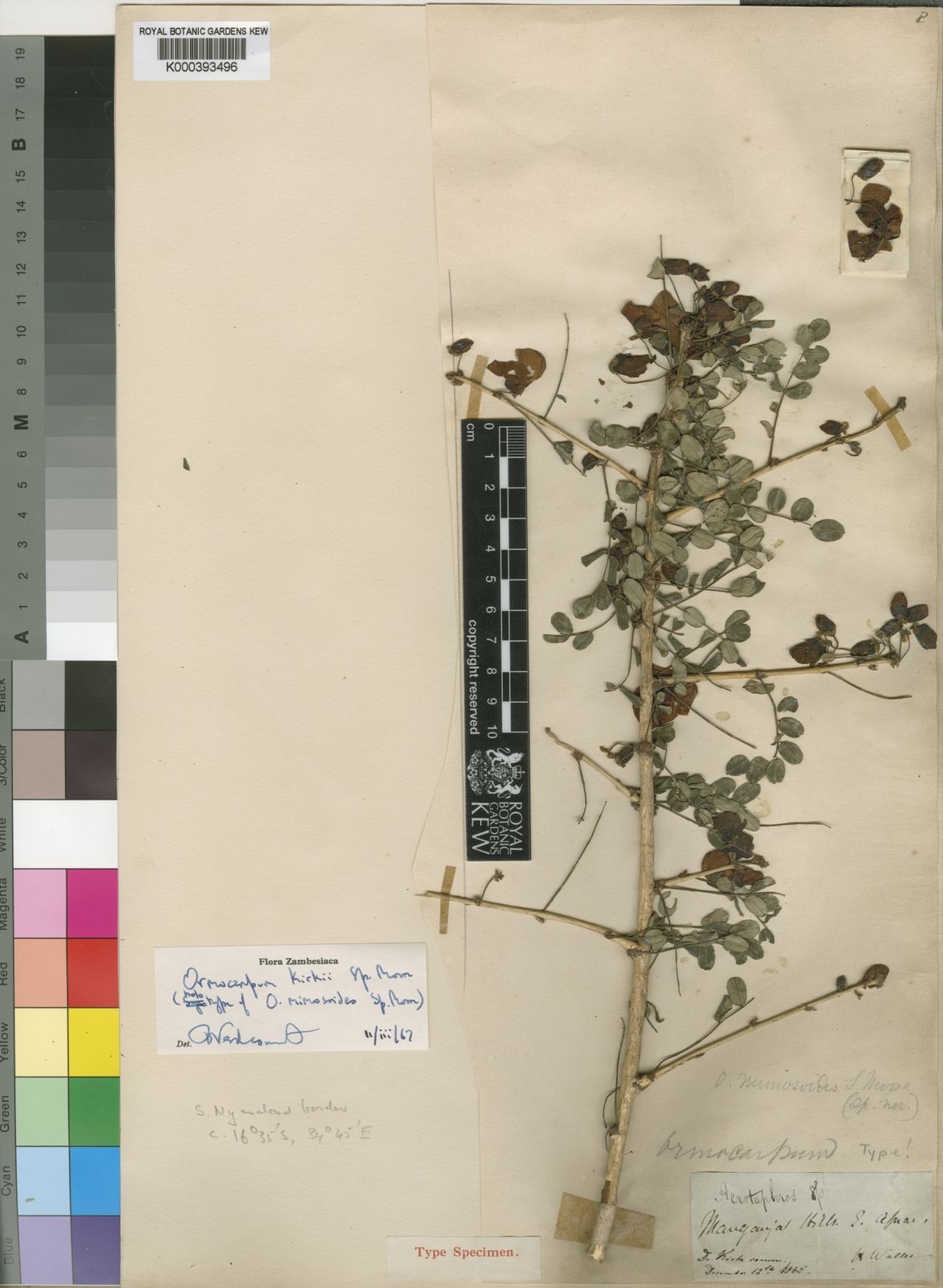Kirk's Ormocarpum
ormocarpum kirkii
Also known as: ["Kirk's Ormocarpum"]
Overview
A leguminous shrub native to tropical regions, valued for its ornamental and potential agroforestry uses.
Benefits & Perks
["wildlife attractant (bees, butterflies, birds)","drought tolerant","aesthetic foliage"]
Botanical Classification
| Phylum: | Magnoliophyta |
| Class: | Magnoliopsida |
| Order: | Fabales |
| Family: | Fabaceae |
| Genus: | Ormocarpum |
| Botanical Name: | Ormocarpum kirkii |
Plant Characteristics
Basic Information
- Category: Shrubs
- Suitable Location: outdoor garden bed in warm, sunny area
- Suitable For:
- Is Weed: No
- Allergenicity: low
Environmental Needs
- Climate: {"temperatureRange":"15–35°C"}
- Hardiness: {"zones":"9–11"}
- Misting: rarely required, only if ambient humidity is very low
- Drainage: Fast-draining to prevent waterlogging.
- Soil Type: Well-draining, loamy soil with added organic matter.
Maintenance Level
- Maintenance Level: moderate
- Toughness Level: moderate
- Pruning Frequency: Annually or as needed to maintain shape.
- Pruning Intensity: Moderate; remove up to one-third of growth if overgrown.
Care Details
Ideal Sunlight Coverage:
Full sun (6–8 hours/day); tolerates partial shade in intense heat.
Sunlight Tolerance Tips:
Acclimate gradually to intense sun; protect from harsh midday sun; adjust placement based on outdoor/indoor conditions.
Care Requirements
Care Difficulty
moderatemoderate
Sunlight
full sun
Rotate plant for even light; use sheer curtains in extreme sun; avoid direct afternoon sun indoors.
Watering
every 7–10 days during active growth, reduce in winter
Water thoroughly but infrequently; ensure soil dries between waterings; avoid overwatering.
Soil
well-drained, sandy loam with moderate organic content
pH: Slightly acidic to neutral (pH 6.0–7.0).
Ensure pots have drainage holes; avoid heavy clay soils; amend with organic matter.
Temperature
Warm temperatures (65–85°F/18–29°C); sensitive to frost; prefers stable conditions.
Avoid sudden temperature changes; protect from frost; maintain consistent warmth.
Fertilizing
every 4–6 weeks during growing season
Fertilize only when actively growing; flush soil occasionally to prevent salt buildup; avoid over-fertilizing.
Propagation
Methods
Stem cuttings or seeds.
Step-by-Step Propagation Guide
- Take a cutting.
- Apply hormone.
- Plant in medium.
- Maintain humidity.
- Wait for roots.
Best Time: Spring or early summer when growth is active.
Environment
High humidity, indirect light, and warm temperatures (70–75°F/21–24°C).
Medium
Well-draining mix like perlite and peat moss.
Hormone
Recommended to promote root development.
Timeline
Roots in 4–6 weeks; establish in 2–3 months.
Tools Needed
Pruners, rooting hormone, small pots, misting spray bottle.
Quick Tips
Use healthy, non-flowering stems; keep consistently moist; provide bottom heat if possible.
Pruning & Repotting
Pruning Guide
Method
Selective cutting of stems; pinch back tips for bushiness.
Pruning Plan
Shape plant, remove dead/damaged growth, and encourage bushier form.
Tools
Pruning shears, sterilizing solution, gloves.
Checklist
Sterilize tools; prune during dormancy; remove dead wood; shape evenly.
Repotting Guide
Best Season
Spring before active growth begins.
Pot Size
One size larger pot; ensure it’s not too big.
Method
Remove plant gently; trim roots if needed; use fresh soil; ensure drainage.
Suggestions
Repot every 2–3 years or when roots fill the pot; improves growth and drainage.
Checklist
Check root bound status; prepare new pot; use fresh soil; water after repotting.
Advanced Care Tips
Watering Mastery
Watering Checklist
Check soil moisture; water deeply; ensure drainage; adjust for season.
How to Apply Water Properly
Water directly at the root zone until water drains from the bottom; ensure even moisture without waterlogging; water in the morning to reduce evaporation.
Watering Schedule Tips
Water deeply once the top inch of soil feels dry; reduce frequency in winter to prevent root rot.
Soil Improvement
Add perlite or sand for drainage; incorporate compost for fertility.
Temperature Stress Management
Signs of Temperature Issues
Wilting, leaf drop, stunted growth, or yellowing in extreme heat or cold.
Cold Stress
Growth halts; leaves may curl or turn brown; risk of frost damage.
Solution: Move to a warmer location; use a heat mat; protect from drafts.
Hot Stress
Wilting, leaf scorch, or reduced flowering in excessive heat.
Solution: Provide shade; increase humidity; water more frequently but avoid waterlogging.
Fertilizing Guide
Fertilizing Checklist
Check growth phase; dilute fertilizer; apply to moist soil; stop in dormancy.
Fertilizing Method
Use balanced liquid fertilizer diluted to half strength every 4–6 weeks during growing season; cease in winter.
Common Problems & Solutions
Toxicity Warning
Cats
ToxicOrmocarpum kirkii is toxic to cats, with ingestion leading to serious health issues. The seeds and leaves contain compounds that can cause severe gastrointestinal and neurological symptoms.
⚠️ Symptoms:
🌿 Toxic Parts:
⚡ Toxic If:
if eaten
Dogs
ToxicIngestion of Ormocarpum kirkii by dogs can result in severe toxicity, affecting the gastrointestinal and nervous systems. The seeds and leaves are the most toxic components.
⚠️ Symptoms:
🌿 Toxic Parts:
⚡ Toxic If:
if eaten
Humans
ToxicOrmocarpum kirkii contains toxic compounds that can cause significant physiological distress upon ingestion. The plant's seeds and leaves are particularly hazardous, leading to gastrointestinal and neurological effects.
⚠️ Symptoms:
🌿 Toxic Parts:
⚡ Toxic If:
if eaten
Frequently Asked Questions
Q: Is Ormocarpum kirkii toxic to pets?
A: Information on toxicity to pets is currently unknown.
Q: What are the primary uses of Ormocarpum kirkii?
A: It is primarily used for ornamental purposes and in agroforestry systems.
Q: How difficult is it to care for Ormocarpum kirkii?
A: It requires moderate care, with attention to watering and sunlight conditions.
Quick Reference
| Family: | Fabaceae |
| Care: | moderate |
| Light: | full sun |
| Water: | every 7–10 days during activ |
Get Expert Care Tips
Download the Plantious app for personalized care reminders and plant identification!
Google Play App Store






